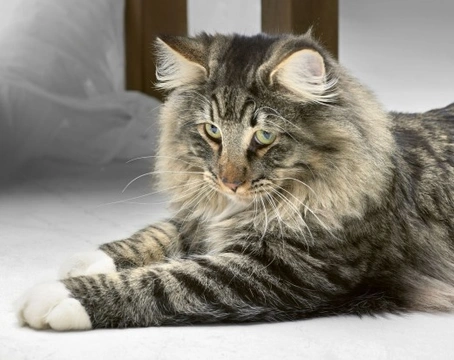
More about the Norwegian Forest cat
The Norwegian Forest cat is a domestic cat breed that originated in Northern Europe, and one that is naturally at home in cold climates, possessing a long, water resistant coat with an extra layer of insulation provided by a denser, more woolly undercoat. One of the larger domestic cat breeds, the Norwegian Forest cat is a robust and visually impressive cat that enjoys spending a lot of time outdoors and roaming around. They are popular as pets both in their home country of Norway and the other Scandinavian countries, and also enjoy a considerable following here in the UK.
The history of the Norwegian Forest cat
The exact origins of this naturally occurring breed are not definitively known, but there is evidence to suggest that the first cats of the breed’s ancestry were probably introduced to Norway with the Vikings in around 1,000 AD.
The cats adapted naturally to thrive in the region’s cold winters, and the breed likely developed from the introduction by Viking invaders of longhaired cats that bred with locally occurring domestic and wild shorthaired cats, to produce the cat breed that we know as the Norwegian Forest cat today.
Norwegian Forest cats were prized for their hunting abilities, and were popular as both farm cats and ship’s cats for this reason. The first Norwegian Forest cat breed association was formed at around the time that the Second World War broke out in 1938, in an attempt to preserve the breed and further its aims. However, these first preservation efforts for the Norwegian Forest cat were hampered by the war in Europe, as the breed interbred in great numbers with non-pedigree domestic cats, leading to the Norwegian Forest cat as a pure breed almost dying out entirely.
After the war, the Norwegian Forest Cat Club made great efforts to preserve and establish the breed, saving this large and noble cat from almost certain extinction. During the 1970’s, the first Norwegian Forest cats were exported to the rest of the world market, and gained recognition as an official breed by most of the world’s formal feline registries by the late 1970’s.
Norwegian Forest cat traits and appearance
The Norwegian Forest cat has a strong, muscular build, and is both taller and heavier than most domestic cat breeds. They have long and glossy fur with a dense undercoat, and a long, bushy tail. They are large boned and heavy, and have voracious appetites! The male Norwegian Forest cat is generally noticeably larger than the female.
The Norwegian Forest cat can be seen in almost any conceivable colour and pattern combination, except for fawn, lilac and cinnamon.
One of the distinctive traits of the Norwegian Forest cat is that they are excellent climbers, thanks to their particularly strong claws. As well as being able to climb trees and other wooden structures, the Norwegian forest cat has even been observed on occasion climbing rocks! Understandably, you would not want to receive a scratch from one of these hard, sturdy claws, but fortunately, the Norwegian Forest cat is calm and good-natured, and highly unlikely to scratch unless threatened.
They enjoy the freedom to roam and plenty of time spent outdoors, and are often competent and prolific hunters.
Norwegian Forest cat personality and temperament
The Norwegian Forest cat is an active, intelligent cat that will soon become bored if they do not receive enough stimulation. They are generally not a good choice for keeping as an indoor-only cat for this reason, and they are incredibly active and often roam over large territories outside of the home. They enjoy plenty of mental stimulation and play, and love having lots of opportunity to climb and simulate hunting behaviour. They are one of the cats that are most likely to be interested in playing with their human keepers, and can provide hours of entertainment (between naps)!
They are generally calm and laid back, if alert and watchful. They are affectionate and enjoy a stable household, and get on well with well-behaved older children. They are generally accepting of sharing their household with other pets if introduced when young and properly socialised, and can fairly be described as a relatively undemanding, self-sufficient cat.
Norwegian Forest cat health
The Norwegian Forest cat is naturally a fairly robust and healthy breed, with an average lifespan of 14-16 years, which is rather older than many other pedigree cat breeds.
While the Norwegian Forest cat is not particularly prone to contracting either minor ills or genetic and hereditary defects, they do have slightly elevated risk factors for two conditions, perinatal hypoglycaemic collapse and glycogen storage disease type IV.
Both of these conditions are caused by a hereditary mutation in the glycogen branching enzyme (GBE1) that is thankfully rare. The presence of this mutation can be established in the parent cats prior to making the decision to breed, and various health programmes and breed databases collate the results of GBE1 testing in order to provide a picture of the incidence rate of associated conditions within the breed.



